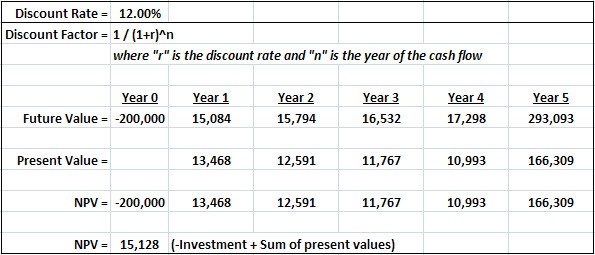Discounted Cash Flow Formula Example
Post on: 12 Апрель, 2015 No Comment

Definition of Discounted Cash Flow
The discounted cash flow is a fundamental analysis equation used to discount future cash flows to get their present value.
Discounted Cash Flow Formula
The discounted cash flow formula is used by financial managers to calculate the time value of money and compounding returns. This is critical when a company is assessing a number of projects and have to prioritize which undertakings will be the most profitable. This sort of fundamental analysis is most critical for real estate and construction companies. Below is the formula for discounted cash flow:
Below are the values for the inputs in the equation:
DPV — discounted present value of the future cash flow
FV — future value of the cash flow
i — interest rate reflecting the cost of tieing up the cash for the investment
n — number of years until the new cash flow materializes
d — discounted rate taken at the beginning of the year
Discounted Cash Flow Example

Since the discounted cash flow is used primarily in real estate, let’s use an example of a hypothetical construction company. Let’s say a construction company is evaluating two projects. Below are the scenarios for each project.
Project A — small apartment complex
Project B — retail office
- 12 million in costs
- 16 million sales price
- 3 years to complete project
In Project A the future cash flow is 2 million. This means that over the course of the year the return would be 2M/8M = 25%. We now have to discount this value to reflect how the cash could have been used over the same period. Let’s assume the 10 million could have been invested in Treasury Notes at a per annum rate of 6%. This would represent $600,000 dollars worth of interest made over the year. So in order to get the present value of the investment, we would take 10M — $600,000 for a total of $9,400,000. Then we subtract the $940,000,000 — $800,000,000 (initial investment) to get the true value of $1,400,000 for Project A. This represents a 17.5% return on the initial investment.
Project B is 4M which is double the money of Project A. The return on the project is 4M/16M = 25%, which is the same rate of return for Project A. Now let’s again assume that if the company did not have to take this project on, they could invest $16M in Treasury Notes at 6% over three years. This would represent 3M dollars worth of interest over the 3 year period. So, in order to get the present value of the investment, we would take 16M — 3M for a total of 13M. Once we subtract 13M — 12M (initial investment) the true value of the deal is 1M. This represents a return on the initial investment of 1M/12M = 8.33%.
Project B returns 8.33%, but this return is over a 3 year period, which is roughly 2.77% return per year. So, while Project A is a smaller deal, it is a better business deal because the return on the initial investment is far greater on a per year basis.














